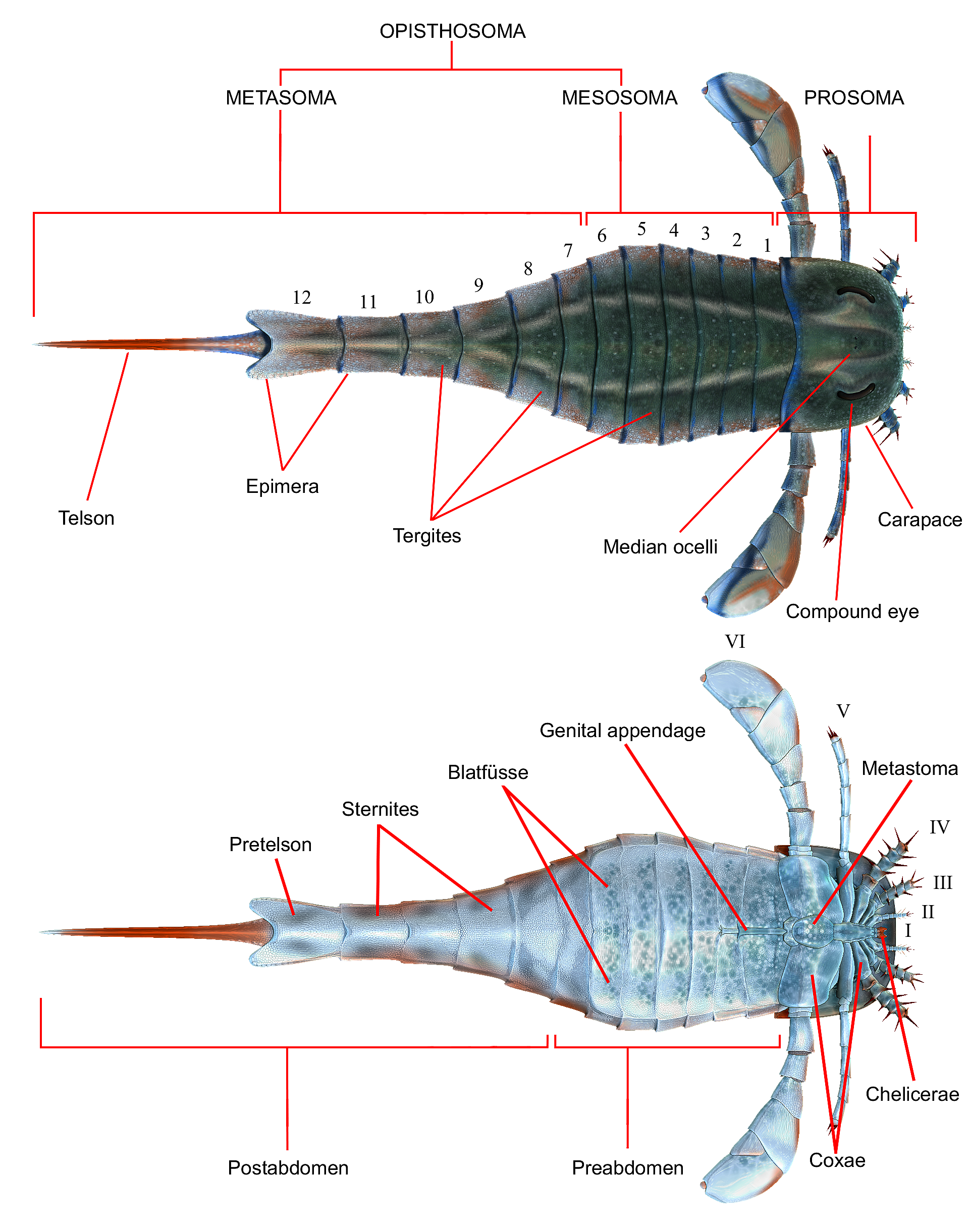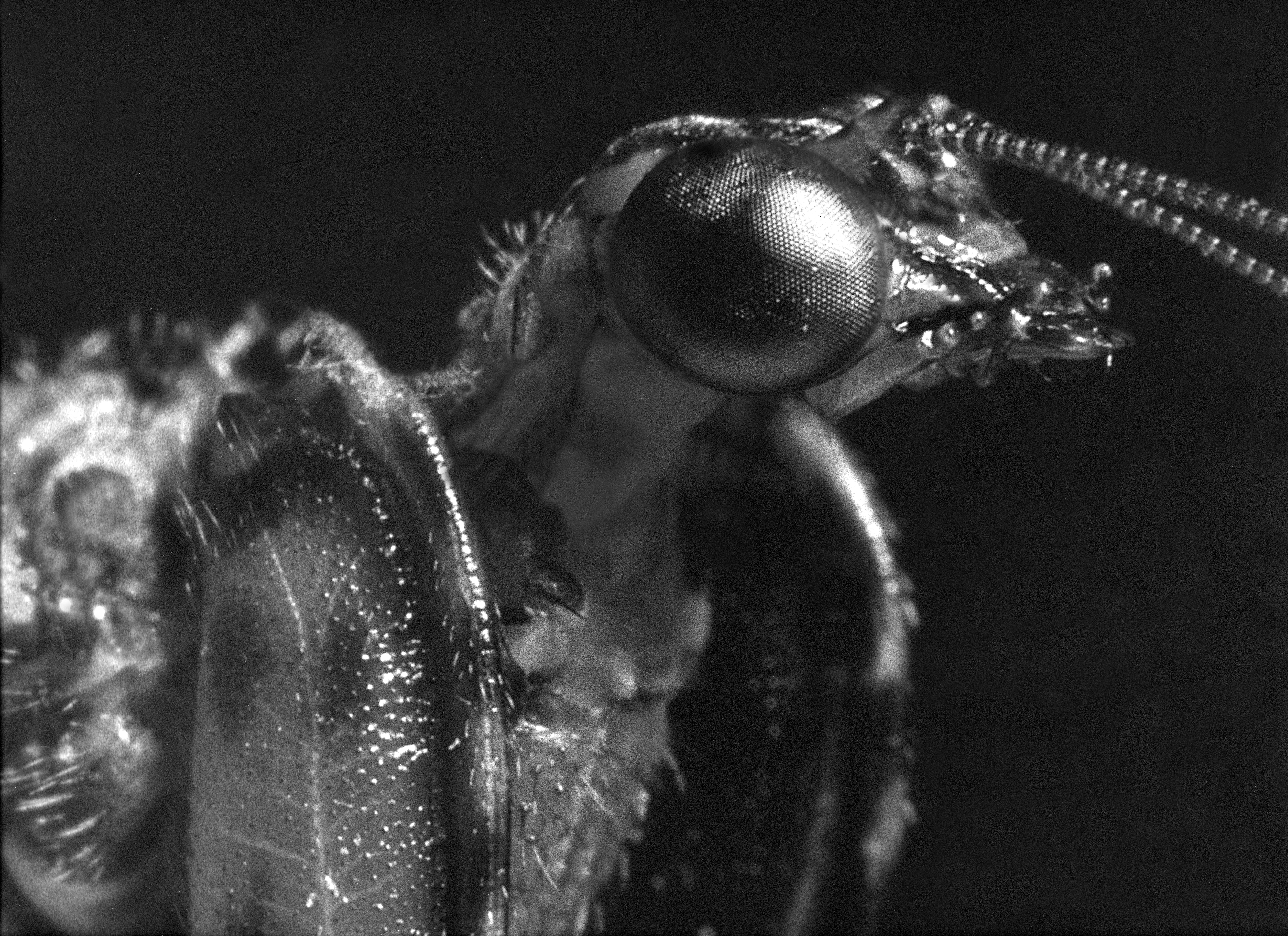|
Campylocephalus
''Campylocephalus'' is a genus of eurypterid, a group of extinct aquatic arthropods. Fossils of ''Campylocephalus'' have been discovered in deposits ranging from the Carboniferous period in the Czech Republic (the species ''C. salmi'') to the Permian period of Russia (species ''C. oculatus'' and ''C. permianus''). The Generic name (biology), generic name is composed of the Greek language, Greek words καμπύλος (''kampýlos''), meaning "curved", and κεφαλή (''kephalē''), meaning "head". It was a member of the hibbertopterid Family (biology), family of eurypterids and probably looked much the same as the other members of the family, ''Hibbertopterus'' and ''Vernonopterus'', in that it was a large, broad and heavy animal quite different from the famous swimming eurypterids (such as ''Pterygotus'' and ''Eurypterus'') which had been common during earlier periods. Like all other stylonurine eurypterids, ''Campylocephalus'' completely lacked swimming paddles. Hibbertopte ... [...More Info...] [...Related Items...] OR: [Wikipedia] [Google] [Baidu] |
Hibbertopterid
Hibbertopteridae (the name deriving from the type genus ''Hibbertopterus'', meaning "Samuel Hibbert-Ware, Hibbert's wing") is a family of Eurypterid, eurypterids, an extinct group of aquatic Arthropod, arthropods. They were members of the superfamily Mycteropoidea. Hibbertopterids were large, broad and heavy animals unlike virtually every other group of eurypterids, which are commonly streamlined and lightweight. Their bizarre morphology is so unusual that they in the past have been thought to represent an entirely distinct order of Chelicerata, chelicerates. Fossils of the family first appear in deposits of Middle Devonian age and the last known fossils representing hibbertopterids are known from deposits of Late Permian age. The hibbertopterids represent the last known living eurypterids, going extinct during the Permian–Triassic extinction event or shortly before. Although eurypterids are commonly known as "sea scorpions", hibbertopterids inhabited freshwater swamps and rivers ... [...More Info...] [...Related Items...] OR: [Wikipedia] [Google] [Baidu] |
Hibbertopterus
''Hibbertopterus'' is a genus of eurypterid, a group of extinct marine arthropods. Fossils of ''Hibbertopterus'' have been discovered in deposits ranging from the Devonian period in Belgium, Scotland and the United States to the Carboniferous period in Scotland, Ireland, the Czech Republic and South Africa. The type species, ''H. scouleri'', was first named as a species of the significantly different ''Eurypterus'' by Samuel Hibbert in 1836. The generic name ''Hibbertopterus'', coined more than a century later, combines his name and the Greek word πτερόν (''pteron'') meaning "wing". ''Hibbertopterus'' was the largest eurypterid within the stylonurine suborder, with the largest fossil specimens suggesting that ''H. scouleri'' could reach lengths around 180–200 centimetres (5.9–6.6 ft). Though this is significantly smaller than the largest eurypterid overall, '' Jaekelopterus'', which could reach lengths of around , ''Hibbertopterus'' is likely to have been the hea ... [...More Info...] [...Related Items...] OR: [Wikipedia] [Google] [Baidu] |
Eurypterid
Eurypterids, often informally called sea scorpions, are a group of extinct marine arthropods that form the Order (biology), order Eurypterida. The earliest known eurypterids date to the Darriwilian stage of the Ordovician period, 467.3 Myr, million years ago. The group is likely to have appeared first either during the Early Ordovician or Late Cambrian period. With approximately 250 species, the Eurypterida is the most diverse Paleozoic Chelicerata, chelicerate order. Following their appearance during the Ordovician, eurypterids became major components of marine faunas during the Silurian, from which the majority of eurypterid species have been described. The Silurian genus ''Eurypterus'' accounts for more than 90% of all known eurypterid specimens. Though the group continued to diversify during the subsequent Devonian period, the eurypterids were heavily affected by the Late Devonian extinction event. They declined in numbers and diversity until becoming extinct during the Permi ... [...More Info...] [...Related Items...] OR: [Wikipedia] [Google] [Baidu] |
Vernonopterus
''Vernonopterus'' is a genus of eurypterid, a group of extinct aquatic arthropods. Fossils of ''Vernonopterus'' have been discovered in deposits of the Carboniferous period in Scotland. The name of the genus derives from the location where the only known fossil has been discovered, Mount Vernon near Airdrie in Lanarkshire, Scotland. A single species of ''Vernonopterus'' is recognized, ''V. minutisculptus'', based on fragmentary fossilized tergites, segments on the upper side of the abdomen. The species name ''minutisculptus'' refers to the ornamentation of scales that covers the entirety of the preserved parts of the eurypterid. Although little can confidently be said about the appearance of ''Vernonopterus'', it is likely to have been similar to its relatives within the hibbertopterid family, ''Hibbertopterus'' and ''Campylocephalus''. The hibbertopterids were large eurypterids with broad heads and bodies and appendages developed for sweep-feeding, a technique involving blade-l ... [...More Info...] [...Related Items...] OR: [Wikipedia] [Google] [Baidu] |
Stylonurine
Stylonurina is one of two suborders of eurypterids, a group of extinct arthropods commonly known as "sea scorpions". Members of the suborder are collectively and informally known as "stylonurine eurypterids" or "stylonurines". They are known from deposits primarily in Europe and North America, but also in Siberia. Compared to the other suborder, Eurypterina, the stylonurines were comparatively rare and retained their posterior prosomal appendages for walking. Despite their rarity, the stylonurines have the longest temporal range of the two suborders. The suborder contains some of the oldest known eurypterids, such as ''Brachyopterus'', from the Middle Ordovician as well as the youngest known eurypterids, from the Late Permian. They remained rare throughout the Ordovician and Silurian, though the radiation of the mycteropoids (a group of large sweep-feeding forms) in the Late Devonian and Carboniferous is the last major radiation of the eurypterids before their extinction in the Pe ... [...More Info...] [...Related Items...] OR: [Wikipedia] [Google] [Baidu] |
Semicircle
In mathematics (and more specifically geometry), a semicircle is a one-dimensional locus of points that forms half of a circle. It is a circular arc that measures 180° (equivalently, radians, or a half-turn). It only has one line of symmetry (reflection symmetry). In non-technical usage, the term "semicircle" is sometimes used to refer to either a closed curve that also includes the diameter segment from one end of the arc to the other or to the half- disk, which is a two-dimensional geometric region that further includes all the interior points. By Thales' theorem, any triangle inscribed in a semicircle with a vertex at each of the endpoints of the semicircle and the third vertex elsewhere on the semicircle is a right triangle, with a right angle at the third vertex. All lines intersecting the semicircle perpendicularly are concurrent at the center of the circle containing the given semicircle. Arithmetic and geometric means A semicircle can be used to construct th ... [...More Info...] [...Related Items...] OR: [Wikipedia] [Google] [Baidu] |
Treatise On Invertebrate Paleontology
The ''Treatise on Invertebrate Paleontology,'' published from 1953–2007 by the Geological Society of America and the University of Kansas, then 2009–present by the University of Kansas Paleontological Institute, is a definitive multi-authored work of currently 55 volumes, written by more than 300 paleontologists, and covering every phylum, class, order, family, and genus of fossil and extant (still living) invertebrate animals. The prehistoric invertebrates are described as to their taxonomy, morphology, paleoecology, stratigraphic and paleogeographic range. However, taxa with no fossil record whatsoever have just a very brief listing. Publication of the decades-long ''Treatise on Invertebrate Paleontology'' is a work-in-progress; and therefore it is not yet complete: For example, there is no volume yet published regarding the post- Paleozoic era caenogastropods (a molluscan group including the whelk and periwinkle). Furthermore, when needed, previously published vol ... [...More Info...] [...Related Items...] OR: [Wikipedia] [Google] [Baidu] |
Prosoma
The cephalothorax, also called prosoma in some groups, is a tagma of various arthropods, comprising the head and the thorax fused together, as distinct from the abdomen behind. (The terms ''prosoma'' and ''opisthosoma'' are equivalent to ''cephalothorax'' and ''abdomen'' in some groups. The terms ''prosoma'' and ''opisthosoma'' may be preferred by some researchers in cases such as arachnids, where there is neither fossil nor embryonic evidence animals in this class have ever had separate heads and thoraxes, and where the ''opisthosoma'' contains organs atypical of a true ''abdomen'', such as a heart and respiratory organs.) The word ''cephalothorax'' is derived from the Greek words for head (, ') and thorax (, '). This fusion of the head and thorax is seen in chelicerates and crustaceans; in other groups, such as the Hexapoda (including insects), the head remains free of the thorax. In horseshoe crabs and many crustaceans, a hard shell called the carapace covers the cephalothorax. ... [...More Info...] [...Related Items...] OR: [Wikipedia] [Google] [Baidu] |
Carboniferous
The Carboniferous ( ) is a Geologic time scale, geologic period and System (stratigraphy), system of the Paleozoic era (geology), era that spans 60 million years, from the end of the Devonian Period Ma (million years ago) to the beginning of the Permian Period, Ma. It is the fifth and penultimate period of the Paleozoic era and the fifth period of the Phanerozoic eon (geology), eon. In North America, the Carboniferous is often treated as two separate geological periods, the earlier Mississippian (geology), Mississippian and the later Pennsylvanian (geology), Pennsylvanian. The name ''Carboniferous'' means "coal-bearing", from the Latin ("coal") and ("bear, carry"), and refers to the many coal beds formed globally during that time. The first of the modern "system" names, it was coined by geologists William Conybeare (geologist), William Conybeare and William Phillips (geologist), William Phillips in 1822, based on a study of the British rock succession. Carboniferous is the per ... [...More Info...] [...Related Items...] OR: [Wikipedia] [Google] [Baidu] |
Permian–Triassic Extinction Event
The Permian–Triassic extinction event (also known as the P–T extinction event, the Late Permian extinction event, the Latest Permian extinction event, the End-Permian extinction event, and colloquially as the Great Dying,) was an extinction event that occurred approximately 251.9 Million years ago, million years ago (mya), at the boundary between the Permian and Triassic geologic periods, and with them the Paleozoic and Mesozoic eras. It is Earth's most severe known extinction event, with the extinction of 57% of Family (biology), biological families, 62% of genera and 81% of marine biology, marine species, (previous estimates of 90–96% marine species extinction were due to historical conflation with the End-Capitanian mass extinction event, end-Capitanian mass extinction which occurred 7–10 million years earlier) and 70% of terrestrial vertebrate species. It is also the greatest known mass extinction of insects. It is the greatest of the "Big Five" mass extinctions of t ... [...More Info...] [...Related Items...] OR: [Wikipedia] [Google] [Baidu] |
Compound Eyes
A compound eye is a visual organ found in arthropods such as insects and crustaceans. It may consist of thousands of ommatidia, which are tiny independent photoreception units that consist of a cornea, lens, and photoreceptor cells which distinguish brightness and color. The image perceived by this arthropod eye is a combination of inputs from the numerous ommatidia, which are oriented to point in slightly different directions. Compared with single-aperture eyes, compound eyes have poor image resolution; however, they possess a very large view angle and the ability to detect fast movement and, in some cases, the polarization of light. Because a compound eye is made up of a collection of ommatidia, each with its own lens, light will enter each ommatidium instead of using a single entrance point. The individual light receptors behind each lens are then turned on and off due to a series of changes in the light intensity during movement or when an object is moving, creating a flic ... [...More Info...] [...Related Items...] OR: [Wikipedia] [Google] [Baidu] |





